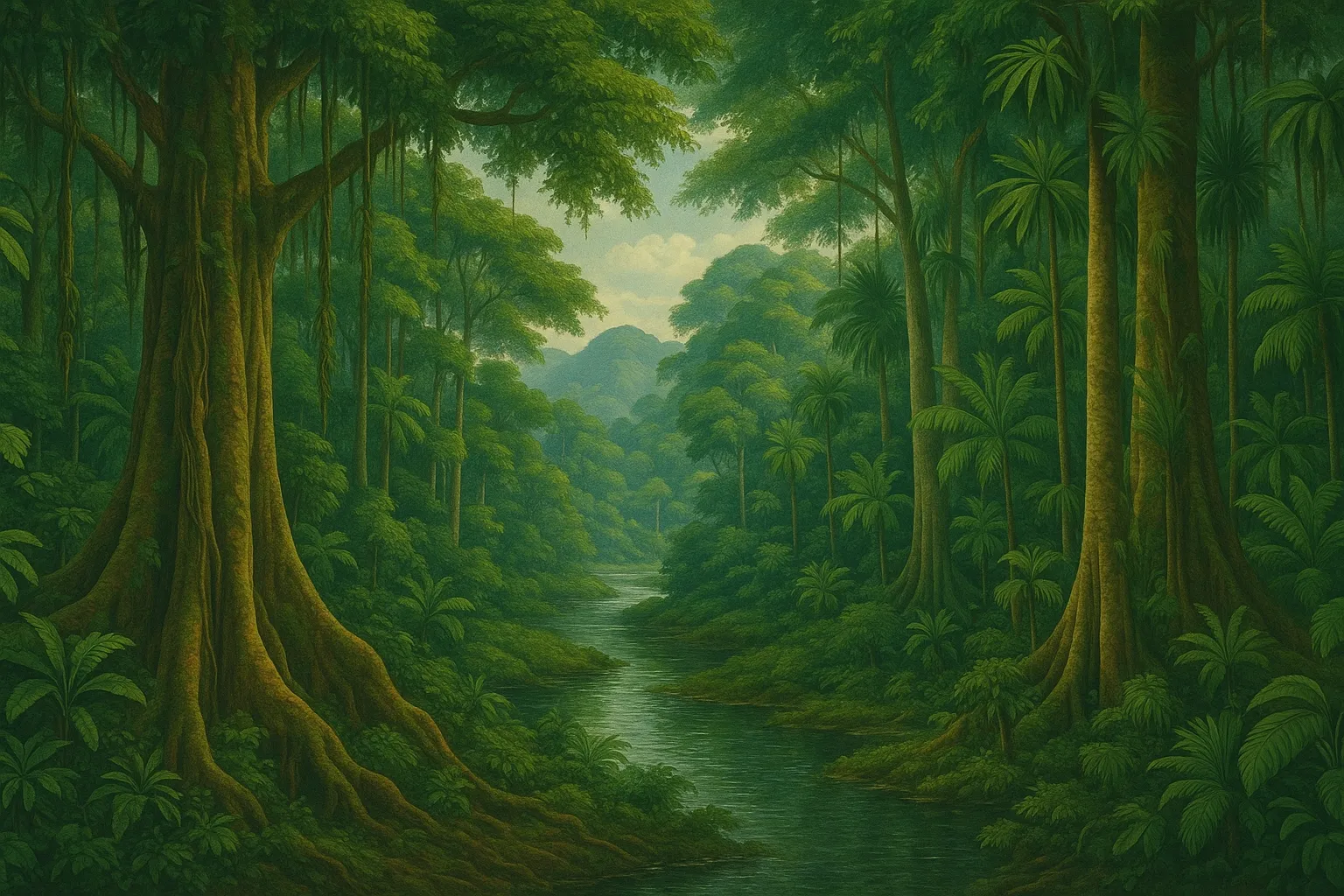Welcome to “Indonesia Overview”! In this edition, we will delve into the green heart of Indonesia: its tropical rainforests. This climax ecosystem is not merely a stretch of trees, but the planet’s largest carbon absorber and reservoir, making it an invaluable asset for Indonesia and the world.
See Table of Contents
Tropical Rainforests: A Perfect Ecosystem Balance and Nutrient Cycle

Tropical rainforests boast the largest biomass and gross primary production, reaching an astonishing $20,000 \text{ KCal/m}^2/\text{yr}$. The abundant leaf biomass in Indonesia’s tropical rainforests leads to a very high rate of photosynthesis, which in turn means immense carbon sequestration capabilities.
In their climax condition, these forests achieve a perfect balance between nutrient needs, water requirements, litter productivity rates, and photosynthesis rates. This phenomenon is known as the “Closed Nutrient Cycle.”
This high rate of photosynthesis is not only vital for carbon sequestration but also supports various other crucial environmental functions. These include water regulation, the creation of stable microclimates, and serving as habitats for diverse wildlife, flora, fauna, and medicinal plants. All of this underscores that Indonesia’s tropical rainforests possess the largest photosynthesis rates and are the largest carbon sinks on Earth.
Indonesia: A Global Biodiversity Hotspot
Tropical rainforests are primarily distributed across three major regions globally: South America (approximately 400 million ha), Indonesia-Malaya (around 250 million ha), and West Africa (about 180 million ha).
Indonesia, in particular, is dubbed a “Megabiodiversity Country.” Although Indonesia’s landmass only accounts for 1.3% of the total land area on Earth, the country hosts 10% of the world’s plants, 12% of mammals, 16% of reptiles and amphibians, and 17% of birds.
These figures illustrate the incredible richness of Indonesia’s biodiversity. For instance, over 38,000 plant species are found in Indonesia, with 55% of them being endemic. Palm species, among the most abundant in Indonesia, number 477, with 225 being endemic. In terms of plant species diversity, Indonesia ranks among the top five globally.
Photosynthesis: The Foundation of Life in Tropical Rainforests
Photosynthesis is an essential biochemical process by which plants, especially those containing chlorophyll, form carbohydrates from inorganic substances. This process is also carried out by algae and certain types of bacteria.
Photosynthesis is profoundly important for life on Earth because almost all living organisms depend on the energy it produces, and most of the oxygen in the atmosphere is also generated through this process. During photosynthesis, free carbon from $CO_2$ is fixed into sugar as an energy-storing molecule.
This complex process occurs in the leaves, specifically in the chloroplasts within the stroma. Photosynthesis is divided into light-dependent reactions (requiring light) and light-independent reactions (not requiring light but needing carbon dioxide). Limiting factors such as carbohydrate translocation, leaf age, and nutrient availability can influence the rate of photosynthesis.
Challenges and the Importance of Sustainable Management of Indonesia’s Tropical Rainforests
The management of tropical rainforests in Indonesia must be carried out with utmost care. Biomass extracted for timber and non-timber forest products must not reduce the rate of photosynthesis and the gross primary production of the forest.
Extracted biomass should be returned in the form of fertilizers (nutrients) in equivalent amounts during planting or enrichment activities, especially in natural production forests. Forest products must also possess high economic value; it would be profoundly incorrect to equate the economic value of tropical rainforest logs, which are hundreds or even thousands of years old, with that of Sengon or Acacia timber aged 10-20 years.
The future of tropical rainforest management in Indonesia must adhere to systems that align with the intrinsic characteristics of the forest itself. Ignoring these systems will lead to environmental degradation, climate change, and potentially the extinction of life on Earth.
Global climate change, a frightening concern for all nations, is largely caused by tropical rainforest deforestation. Damage to tropical rainforests, such as from forest and land fires or landslides, can fundamentally destroy the ecosystem and reduce photosynthesis and carbon absorption rates to zero.
The following table illustrates the vital role of tropical rainforests compared to other ecosystems in terms of gross primary production:
| No. | Ecosystem | Gross Primary Production (KCal/m²/yr) |
|---|---|---|
| 1. | Deserts & Tundra | 200 |
| 2. | Grasslands | 2,500 |
| 3. | Dry Land Forests | 2,500 |
| 4. | Conifer Forests | 3,000 |
| 5. | Wet Temperate Forests | 8,000 |
| 6. | Agriculture | 12,000 |
| 7. | Subtropical & Tropical Forests | 20,000 |
Forests are often called the “mother of all rivers,” and the relationship between forests and water has long been recognized by communities. The impacts of forests are directly felt by residents, ranging from floods, droughts, erosion, to climate change and sedimentation that can threaten civilization.
Conclusion
As part of “Indonesia Overview,” we recognize our immense responsibility to protect and preserve Indonesia’s tropical rainforests. These forests are not merely the lungs of the world; they are also an unparalleled reservoir of biodiversity and a crucial ecological pillar for life across the Nusantara and the entire Earth. Through wise and sustainable management, we can ensure this natural wonder endures for future generations.
The in-depth information presented in this article is distilled from an enrichment material titled “HUTAN HUJAN TROPIK MERUPAKAN EKOSISTEM PENYERAP DAN PENYIMPAN KARBON TERBESAR DI PLANET BUMI” (Tropical Rainforests are the Largest Carbon Absorbers and Reservoirs on Earth). This material was prepared by Basuki Wasis, a faculty member in the Department of Silviculture, Faculty of Forestry and Environment, IPB University. You can access the full material and other fascinating studies by him on ResearchGate.
The natural beauty of Indonesia extends far beyond its tropical rainforests. There are many other captivating wonders waiting to be explored. To delve deeper into Indonesia’s stunning natural landscapes, you can find various other engaging pillar content on our blog’s main page: Natural Beauty of Indonesia.
